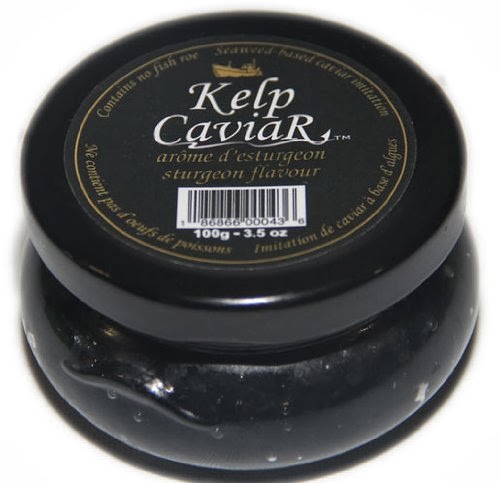At the kelp caviar factory, They begin production with kelp that's been dried naturally, Then ground into a fine powder. The other ingredients are salt, citric acid, And, if they're making a flavored variety, Natural flavoring in liquid form. They add the ingredients one at a time to water. The mixer blends them thoroughly for about an hour, Producing a thick, gelatinous liquid. They transfer the mixture into a pot Connected to an extrusion machine. The machine pumps the mixture Through what looks like a showerhead, Only instead of outputting a steady stream, It squeezes out droplets, Producing tiny kelp balls called pearls, Which look exactly like fish eggs.
The pearls drop into a coagulation solution. Besides providing a soft landing, This solution helps hold the pearls' shape. The pearls roll down a chute into waiting containers. The water drains out the bottom. Workers empty the containers into large colanders. Then they rinse and strain the pearls To ensure they're all a certain minimum size. Pearls that are too small Simply fall through the colander's holes. They weigh out a specific quantity And mix in
an all-natural stabilizer Required to maintain the pearls' texture and round shape. The factory's quality-control lab Tests a sample from the batch To make sure the ph level is just right. Careful ph control, coupled with pasteurization, Is why this product doesn't require any preservatives. At the packaging station, workers fill glass jars, Then twist a tin lid onto each one.
Then the jars go into a pasteurization machine. It heats the caviar to a high temperature For a specific period of time, Which kills off any bacteria. This ensures a two-year shelf life without refrigeration. Once opened, the product stays fresh in the fridge For three months. After printing each lid with a lot number For tracking purposes, All that's left to do is dress the jar in a cardboard label. Kelp caviar contains no artificial colors or flavors. Unlike certain types of caviar, It doesn't bleed color to the surrounding food, Even when baked. And while real caviar Is typically either black sturgeon roe or red salmon roe, Kelp caviar comes in additional flavors, Such as truffle, cognac, and wasabi.
